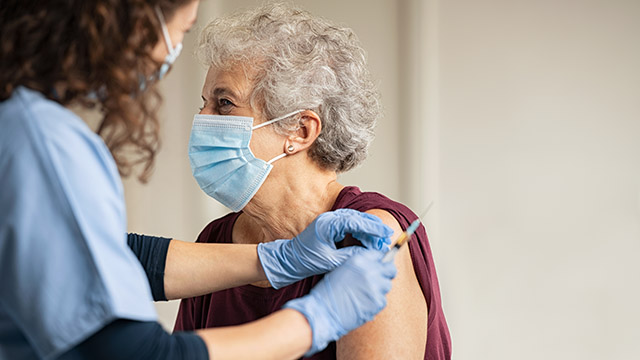The Centers for Disease Control (CDC) has stated vaccinated people can gather with other vaccinated people without masks. What does this mean for you?
Northwestern Medicine experts unpack the details of this new stage of the pandemic.
In this Q&A, there are insights from Dr. Benjamin Singer, assistant professor of medicine in pulmonary and critical care at Northwestern University Feinberg School of Medicine, Mercedes Carnethon, vice chair of preventive medicine at Feinberg, Dr. Michelle Prickett, associate professor of medicine in pulmonary and critical care at Feinberg, and Dr. Robert Murphy, executive director of the Institute for Global Health at Feinberg.
If a friend or family member are completely vaccinated, can we see each other indoors without masks? Is there a limit to how many vaccinated people can gather together indoors?
Mercedes Carnethon: “The interim CDC guidelines suggest it is relatively safe for individuals who are fully vaccinated to meet together indoors without masking or social distancing.”
Dr. Michelle Prickett: “Two or more vaccinated people may meet indoors without masks or social distancing measures as both parties are at very low risk of either symptomatic or asymptomatic infection. These encounters should be in non-public areas and limited to small gatherings. Moderate or large groups are still encouraged to practice all infection-reduction methods at this time.”
Does being fully vaccinated affect my ability to be in indoor public spaces — must I still wear a mask?
Dr. Robert Murphy: “If you are in an indoor public area with vaccinated and unvaccinated people, nothing has changed. You still need a mask and social distancing.”
Dr. Benjamin Singer: “While it is likely that vaccines prevent asymptomatic infection and decrease the likelihood that a vaccinated person can transmit the virus, the CDC does not yet have sufficient confidence in the existing data to ease precautions in public. My view is that these data are rapidly evolving and that the recommendations will change as we know more.”
Carnethon: “One reason masking is still required in public spaces is that there are undoubtedly individuals who are ineligible for vaccination (i.e., children under age 16) or unwilling or unable to be vaccinated. It is too early to assume all age-eligible adults have had access to a vaccine and so vaccinated adults should reinforce the public health messages around basic mitigation strategies including masking, hand washing and distancing.”
What about being outdoors — should I still wear a mask, say, on a walking trail or in a park?
Murphy: “If you are alone in the woods, no need for masks. If you run into someone, you still need to be masked and socially distanced.”
Singer: “Recommendations for outdoor masking have not changed, although the risk of transmission in a sparsely populated outdoor space is minimal and likely approaches zero for a fully vaccinated person.”
Can I eat outdoors at restaurants if my table is socially distanced from other diners?
Prickett: “Outdoor dining is safer than indoors as COVID is spread through both droplets and aerosols. In the case of outdoor restaurants, there are still potential exposers from wait staff and other patrons in the area. Continuing with masking except when eating should still be considered even with outdoor dining until more individuals are vaccinated.”
What needs to happen before we can all remove our masks and resume normal pre-COVID-19 life?
Singer: “Unfortunately, the risk of COVID will be with us for some time. While vaccine rates are ramping up, particularly among vulnerable populations, we can expect recommendations to continue masking in public. But I am hopeful that we will see easing of recommendations for vaccinated people as the data evolve over the coming months.”
Prickett: “The last year has shown us how important masking can be to reduce COVID but also other viral infections. We have seen unprecedented decreases in other respiratory illnesses such as influenza this past year related largely to masking and other infection-prevention measures. I would expect a reduction in need for universal public masking to slowly decrease as we see more vaccinations and fewer cases in the coming months.
“However, we should still consider the valuable lessons learned on the importance of masking when potentially sick or in tight public spaces (i.e. planes, mass transit). Masking on some level should remain a part of ongoing public health initiatives for all respiratory illnesses.”
Could there be a new wave of COVID caused by the new variants that are less susceptible to the current vaccines? Could things get worse again?
Singer: “We are keeping a close eye on the spread of SARS-CoV-2 variants that spread more easily and could cause another surge in cases. As it remains to be seen what effect these variants will have on case rates, it makes sense to continue ramping up vaccines and wearing masks in public and among unvaccinated individuals.”
Carnethon: “There are concerns that the rate of mutations will compromise the progress we are making in lowering the rate of new cases and resulting deaths and hospitalizations. The longer the virus circulates in the population, the more opportunity it has to mutate to make itself more efficient at infecting its hosts. At present, there does not appear to be evidence that the new variants can completely bypass the vaccines we have, so it is important to keep up the pace of vaccinations so that we can stay ahead of the viral mutations. ”
“I also remain concerned that if adults who are in close contact with children younger than age 16, we could see continued viral spread amongst youth — even while the adults are protected from severe outcomes. There may be a time when the adults in the household are negative, but the children are positive.”

